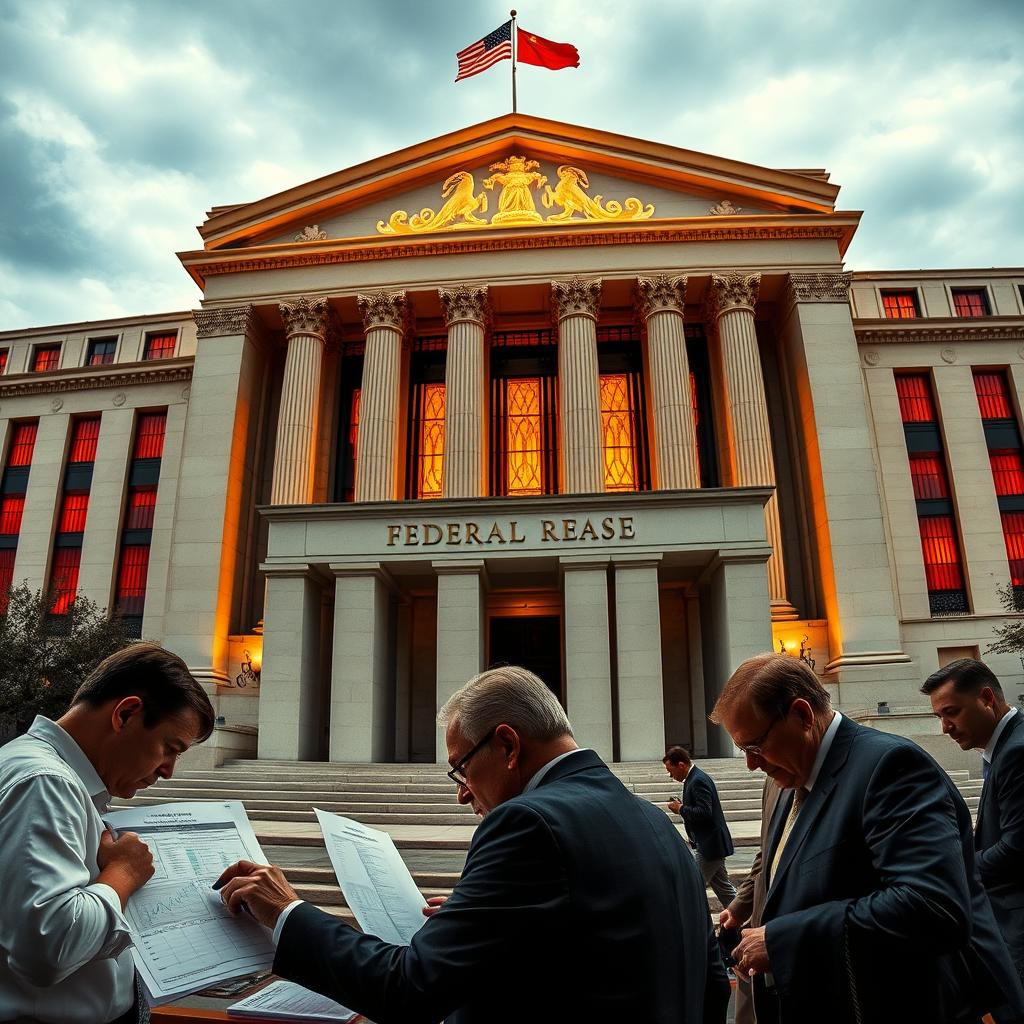The Federal Reserve has recently cut interest rates. This move is causing waves in the global economy. If you’re a consumer or investor, you might be thinking about how this affects your future.

This change in monetary policy is a big deal. It’s aimed at helping the economy grow. With the U.S. economy at a turning point, this decision is key to understanding your investments and financial choices.
Key Takeaways
- The Federal Reserve’s decision to cut interest rates is a strategic move to boost economic growth.
- This monetary policy shift has implications for investors and consumers alike.
- Understanding the reasons behind the rate cut is essential for making informed financial decisions.
- The impact of the rate cut will be felt across various sectors, including housing and stock markets.
- Staying informed about the Federal Reserve’s actions is crucial for navigating the changing economic landscape.
Breaking Down the U.S. Fed Interest Rate Cut
The U.S. Fed has cut interest rates, affecting financial markets and the economy. This move shows the Fed’s efforts to handle the economic situation.
The Magnitude and Timing of the Rate Reduction
The Federal Reserve has cut rates by 0.25%. Many expected this move. The timing is important, given global economic worries. This cut aims to boost growth by lowering borrowing costs.
Key Points from the Federal Reserve’s Official Statement
The Fed’s statement outlined reasons for the rate cut. These include slowing economic growth, low inflation, and the need to preemptively adjust monetary policy. The Fed also promised to keep the economy stable.
| Key Points | Description |
|---|---|
| Economic Growth | Slowing growth rates globally |
| Inflation | Low inflation environment |
| Monetary Policy | Preemptive adjustment to maintain stability |
Immediate Market Reactions to the Announcement
After the announcement, stock markets jumped. Major indices rose as investors welcomed the rate cut. The dollar fell slightly against major currencies, and bond yields dropped. These changes show how monetary policy affects markets.
Economic Factors Behind the Fed’s Decision
The U.S. Federal Reserve cut interest rates due to many economic factors. It’s important to understand these to see how this policy change affects us.
U.S. Inflation Data and Employment Statistics
The Fed looked closely at U.S. inflation and job numbers. They wanted to see if inflation was too high and if jobs were stable. These factors help the Fed make sure the economy is doing well.
Banking Sector Stability Concerns
The Fed worried about the stability of banks too. They saw problems with regional banks and needed to find ways to keep money flowing.
Regional Banking Challenges
Regional banks were facing tough times. They had to deal with more competition and strict rules. The Fed hoped to help them by making money cheaper.
Liquidity Measures
To fix liquidity issues, the Fed took action. They used repo operations and quantitative easing to keep the financial system stable.
International Economic Pressures Influencing the Fed
and global economic slowdown affected the Fed’s choice. The world’s economy is connected, so what happens overseas can impact the U.S.
Historical Perspective: Comparing Past Rate Cut Cycles
Looking at past rate cut cycles helps us understand the Fed’s latest move. The Federal Reserve’s decision to cut interest rates is part of a larger economic plan. This plan has been used in different economic times.
The 2008 Financial Crisis vs. Current Situation
The 2008 financial crisis led to a big rate-cutting cycle by the Fed. Comparing this to today shows both differences and similarities. Back then, the global economy was on the edge, needing drastic actions. Now, the Fed is trying to prevent economic downturns.

Economic Outcomes of Previous Rate-Cutting Periods
Rate-cutting periods have had different economic results. Knowing these results helps us guess what might happen now.
Impact on GDP Growth
GDP growth shows how well the economy is doing. Rate cuts have helped boost GDP during slowdowns. For example, in 2001, rate cuts helped GDP grow in the following years.
Effects on Unemployment Rates
Rate cuts can also lower unemployment rates by making it easier to get jobs. Looking at past rate cuts shows that unemployment often goes down as the economy grows.
How This Rate Cut Affects Your Personal Finances
The U.S. Fed has cut interest rates, and it’s important to know how this impacts you. This change affects many parts of your finances, like loan rates, savings, and credit card rates.
Potential Changes to Your Loan Interest Rates
Lower interest rates can mean smaller monthly payments on your loans. Let’s look at how this might change for different loans:
Home Loans and Mortgages
A drop in interest rates can lower your monthly mortgage payments. For example, a ₹50 lakh home loan at 8% interest could save you ₹1,400 a month with a 0.5% rate cut.
Auto Loans and Personal Loans
Interest rates on auto and personal loans might also go down. This makes it easier to finance a car or cover personal expenses. It might be a good time to consider a big purchase.
Credit Card Interest Rate Adjustments
Credit card rates aren’t directly tied to the Fed’s rates. But, a competitive market might lead banks to lower their rates. Watch for changes from your credit card issuer, as lower rates can save you money.

Impact on Your Savings and Fixed Deposits
Lower interest rates also mean lower returns on savings and fixed deposits. This might make you rethink your savings plan. You might look for other investments that offer better returns.
In summary, the U.S. Fed’s rate cut has big implications for your finances. Understanding these changes helps you make better decisions about loans, savings, and your financial plan.
Opportunities and Risks for Indian Investors
When the U.S. Fed cuts interest rates, Indian investors face new challenges. These changes affect many investment options in India.
Stock Market Investment Strategies Following the Rate Cut
Adjusting your stock market plans is crucial after the Fed’s move. The rate cut could make the market more liquid, possibly raising stock prices.
Sectors Likely to Benefit
IT, pharmaceuticals, and consumer goods might grow. This is because they are sensitive to global trends and could see more demand.
Potential Underperformers
However, banking and financial services might struggle. Lower interest rates could hurt their lending business.
Bond Market Implications for Indian Investors
The bond market will also see changes. With the rate cut, bonds with higher rates could become more appealing, pushing their prices up.
Investing in long-term government bonds or high-quality corporate bonds could be smart.
| Bond Type | Pre-Rate Cut Yield | Post-Rate Cut Yield |
|---|---|---|
| 10-Year Government Bond | 6.5% | 6.0% |
| Corporate Bond (AAA) | 7.0% | 6.8% |
Gold and Commodity Investment Considerations
Gold and other commodities are safe during economic uncertainty. The rate cut might weaken the dollar, making gold more appealing.
Adding gold or commodity funds to your portfolio could protect against market swings.

Impact on India’s Economic Landscape
The recent rate cut by the U.S. Fed is set to affect India’s economy. It will influence IT exports and domestic monetary policy. India’s economy is closely linked to global financial trends.
Effects on India’s IT and Export-Oriented Industries
The U.S. Fed’s rate cut might make the dollar weaker. This could make Indian IT services more competitive globally. It might lead to more exports and revenue for Indian IT companies.
However, a weaker dollar could also make imports more expensive. This could affect industries that rely on imported goods.
Foreign Direct Investment Trends Following U.S. Rate Cuts
U.S. rate cuts have historically boosted foreign direct investment (FDI) in emerging markets like India. With lower U.S. interest rates, investors might look for higher returns in India. This could increase FDI inflows, benefiting India’s infrastructure and growth projects.
Reserve Bank of India’s Potential Policy Responses
The Reserve Bank of India (RBI) might reassess its monetary policy after the U.S. Fed’s rate cut. The RBI could adjust interest rates or use liquidity management strategies to keep the economy stable.
Interest Rate Decisions
The RBI might cut interest rates to keep Indian exports competitive and boost domestic growth. But, it must balance this against the risk of inflation.
Liquidity Management Strategies
The RBI could use strategies like open market operations or adjusting reserve requirements. These actions would help manage the U.S. rate cut’s impact on India’s financial markets. They aim to maintain stability and prevent excessive volatility.
Global Economic Consequences
The U.S. Fed’s decision to cut interest rates has caused waves in the global economy. It has touched many sectors and economies around the world. It’s important to grasp the wide-reaching effects of this action to move through the changing economic scene wisely.
Currency Market Fluctuations and the Indian Rupee
The interest rate cut will likely shake up currency markets. The Indian rupee, in particular, might see big swings against the U.S. dollar. “The rupee’s value is closely tied to the dollar, and any significant change in U.S. interest rates can impact the rupee’s stability.” Be ready for currency market ups and downs, which can sway your investments and financial choices.
Emerging Markets’ Reactions to Fed Policy Changes
Emerging markets, like India, might react in various ways to the Fed’s policy shift. Lower U.S. interest rates could draw investors to these markets. Yet, it might also lead to money flowing out if investors seek better returns elsewhere. Keep an eye on how emerging markets react to the rate cut, as it could shape your investment plans.
International Trade Dynamics in a Lower Rate Environment
A lower interest rate setting can alter international trade patterns. With cheaper borrowing, countries might buy more, boosting global trade. But, this could also spark trade imbalances and protectionist measures. Be mindful of these shifts in international trade and their effects on your business or investments.
As the global economy keeps evolving, staying updated on the U.S. Fed’s rate cut is crucial. Understanding its effects on currency markets, emerging markets, and trade is key. This knowledge helps you make better choices about your finances and investments.
Expert Analysis and Future Outlook
The U.S. Fed has cut interest rates, sparking a lot of talk about the global economy. Investors and financial experts are trying to figure out what this means.
Wall Street and Global Financial Institutions’ Perspectives
Goldman Sachs says the rate cut is because of economic worries. Wall Street sees it as a way to stop a possible downturn. The IMF also supports the move, saying it could help calm markets worldwide.
Indian Financial Experts’ Recommendations for Investors
Indian financial experts say investors should be careful but also look for chances. Mihir Mehta suggests adding assets that do well when interest rates are low. This includes real estate and dividend-paying stocks.
Predictions for the Fed’s Rate Path Through 2023-2024
There are different views on what the Fed will do next. Some think there will be more rate cuts to help the economy. Others think rates might stay the same to see how the last cut works out. Mark Zandi, from Moody’s Analytics, thinks rates will slowly go down through 2023-2024.
Conclusion: Strategically Positioning Your Finances Amid Changing Rates
When the U.S. Fed cuts interest rates, it’s key to know how it affects your money plan. You must act quickly to get the most from your investments and avoid big risks.
Adjust your investment mix, think about how lower rates change your loans and credit cards, and watch the economy closely. Knowing the Fed’s rate plans and how they affect the world economy helps you make smart choices.
Being up-to-date on interest rate changes helps you build a strong money plan that fits your goals. As the economy shifts, staying flexible and ready for rate changes is vital.
FAQ
What does the U.S. Fed’s interest rate cut mean for the economy?
The U.S. Fed interest rate cut aims to boost the economy. It makes borrowing cheaper. This could lead to more spending and business investments.
How will the rate cut affect my mortgage or home loan?
The rate cut might lower interest rates on home loans. This could make borrowing cheaper. You might see lower monthly payments or the chance to refinance at a better rate.
Will the rate cut impact my savings and fixed deposits?
Yes, the rate cut can change interest rates on savings and fixed deposits. Banks might lower these rates. This could mean lower returns on your savings.
How might the rate cut influence the stock market?
The rate cut could increase market liquidity, boosting stock prices. Real estate and consumer goods might see benefits from lower interest rates.
What are the implications of the rate cut for Indian investors?
Indian investors should review their strategies due to the rate cut. It could change how attractive different assets are, like stocks and bonds.
How will the U.S. Fed’s rate cut affect the Indian rupee and currency markets?
The rate cut might cause currency market fluctuations. This could affect the rupee’s value against the U.S. dollar. It might also impact India’s trade and economy.
What are the potential responses of the Reserve Bank of India to the U.S. Fed’s rate cut?
The Reserve Bank of India might adjust its policies in response. This could include changing interest rates or liquidity strategies to keep the economy stable.
How might the rate cut impact foreign direct investment trends in India?
The rate cut could change foreign direct investment trends in India. It might make the country more or less attractive to foreign investors. The outcome depends on global economic conditions.
What are the predictions for the Fed’s future rate decisions?
Experts have different opinions on the Fed’s future rate decisions. Some think there will be more cuts, while others predict a pause or even a rate hike. This depends on economic data and global events.







Comments (0)